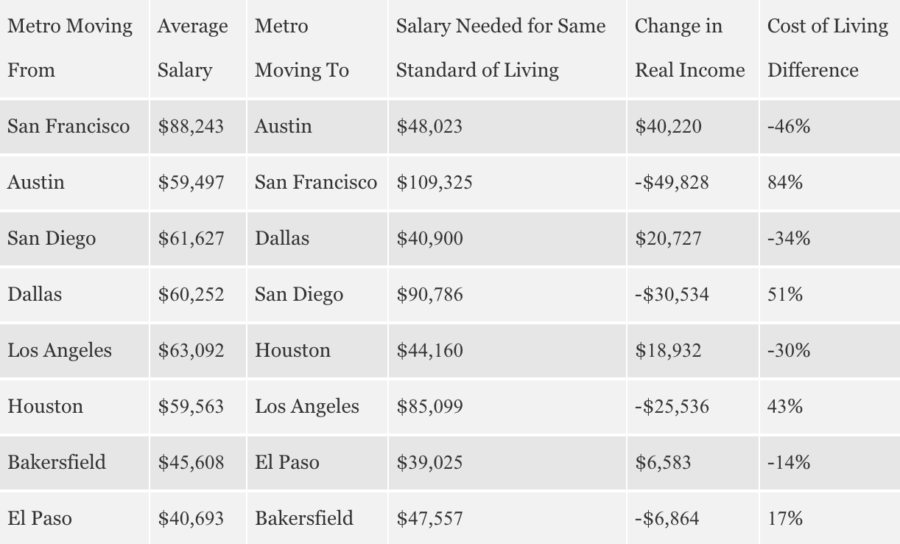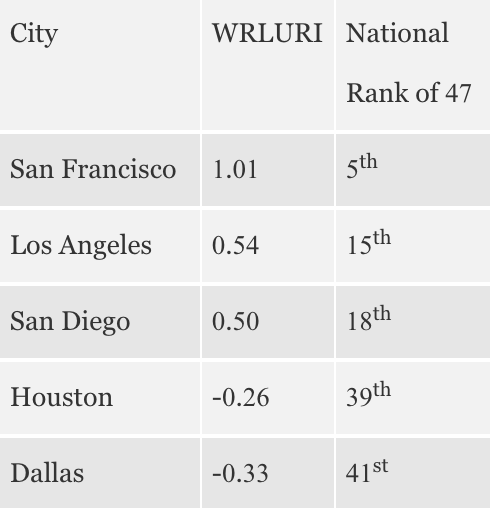Citing a report from Hired, a job site, the Austin Business Journal ran an article headlined, “Study: When adjusted for cost of living, Austin tech workers make more than San Francisco peers.” The piece observed, “…for the fourth year in a row, Austin tech workers have the highest average salary when adjusted based on cost of living… (with) Austin’s tech workers… making an average of $125,000 a year (meaning) an Austin tech employee would, on average, need an $83,000 raise to maintain the same standard of living in San Francisco…”
Is this assertion true? And, if so, why?
According to the cost-of-living calculator on the BankRate.com site, the average monthly rent in San Francisco is $3,230 compared to $1,073 in Austin—a whopping 201% higher in San Francisco. BankRate.com’s cost-of-living calculator provides average costs for a large basket of goods and services by metropolitan area, using analysis from the Council for Community and Economic Research (C2ER) derived from U.S. Census Bureau data.
C2ER estimates that the overall cost-of-living in San Francisco is 84% higher than in Austin. So, according to C2ER’s estimate, that average Austin tech worker looking to move to the Bay Area would need to make $230,000 to maintain the same standard of living—a little more than the $208,000 calculated by Hired.
The table below compares average salaries in eight major cities in California and Texas. It shows a similar pattern in the six additional cities compared, though none quite as stark as in the San Francisco to Austin matchup. In each case, a worker moving from California to Texas and earning the same salary would see a significant improvement to their effective salary due to California’s high cost of living and Texas’ reasonable cost of living.

So, why the big difference? Location has something to do with the cost differences, but it can’t explain all of it. Rather, land use restrictions, environmental regulations, anti-development lawsuits, and development fees have a significant effect on the cost of housing and rental prices. Housing market studies indicate that restrictive land use policies can account for from 30% to as much as 60% of the price of a house.
The Wharton School of the University of Pennsylvania (President Trump’s alma mater) completed a landmark survey of land use restrictions in 2006, publishing, “A New Measure of the Local Regulatory Environment for Housing Markets: The Wharton Residential Land Use Regulatory Index.” The Wharton researchers looked at three sets of questions as they surveyed communities across the nation:
- The general regulatory process, such as what body runs it; who can approve or veto zoning changes; and factors that influence the regulatory process at the local level
- Local land use regulation rules, including legal limits on construction, minimum lot sizes, affordable housing and open space requirements, and development fees
- Regulatory process outcomes, such as the cost of lot development over a decade and project approval time
With these criteria, they developed enough information to rank 47 major cities using the Wharton Residential Land Use Regulatory Index (WRLURI). Of those, five were in the comparison table above with San Francisco having the fifth-most burdensome land use restrictions of the cities ranked. Wharton’s index closely tracks the cost-of-living differences in each city.

President Trump identified excessive land use regulation as a problem this week when he signed an Executive Order creating the White House Council on Eliminating Barriers to Affordable Housing Development. This new interagency council has a mandate to remove government regulations that discourage the construction of affordable homes. The White House announcement cited a premium of 25% on the cost of a new home due to Federal, State, and local regulations and up to 42% for new multifamily units. Further, the announcement noted, the regulatory climate has discouraged supply from meeting demand, with only seven homes built for every 10 households created in the period 2010 to 2016.
Returning to Texas, the Austin Business Journal piece cited a survey that found that Austin was the top-ranked city for tech workers to relocate worldwide, just ahead of Seattle and Amsterdam. That ranking is largely based on past decisions that allowed the city’s housing market to keep up with demand. But unfortunately, Austin’s city council has shifted to the left over the past few years and has become increasingly hostile to both new development and road construction, with the city becoming more expensive and congested as a result. Were it not for the fact that most other tech havens are even further to the left politically, Austin would likely lose its No. 1 ranking.